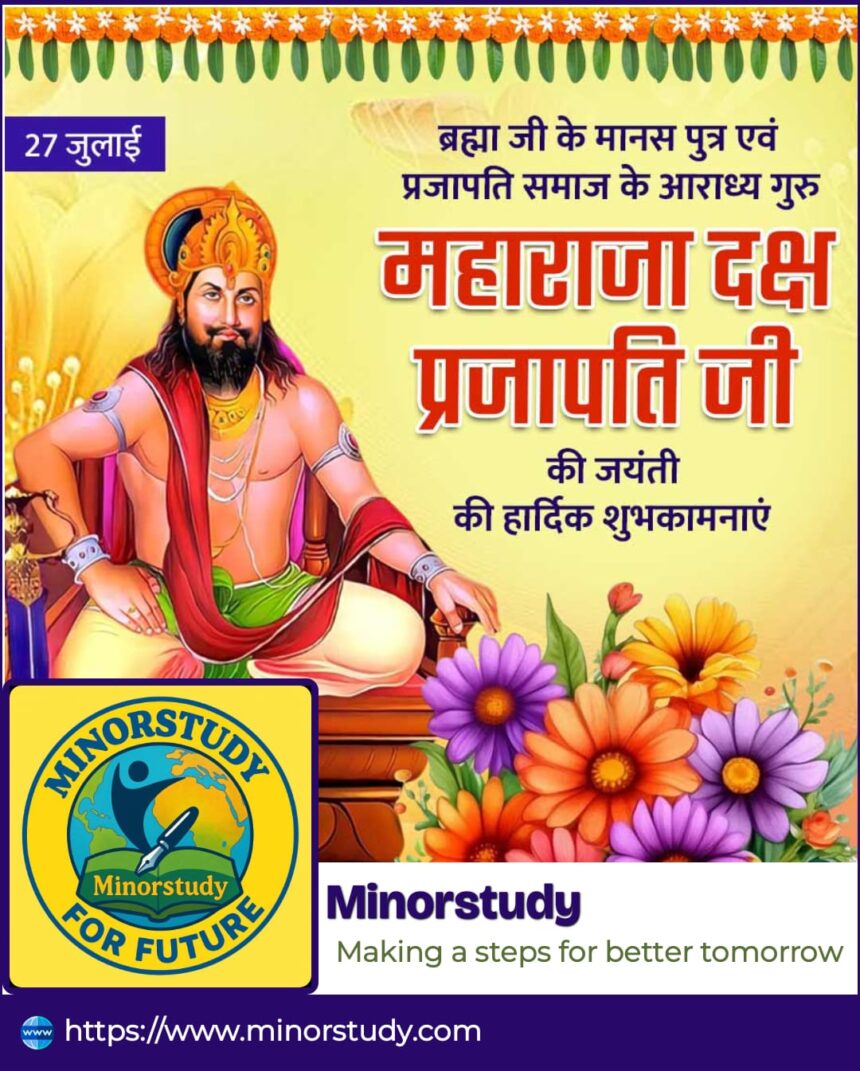9 Powerful Lessons from the Tragic Tale of Maharaja Daksha Prajapati Ji – A Mythological King’s Legacy of Ego, Devotion, and Cosmic Balance
In the vast ocean of Sanatan Dharma, certain mythological figures are remembered not just for their actions, but for the lessons they left behind. One such name, deeply etched in Indian philosophical and religious tradition, is Maharaja Daksha Prajapati Ji.
- 🕉️ Who Was Maharaja Daksha Prajapati Ji?
- 📜 Timeline: Mythological Journey of Maharaja Daksha Prajapati
- 📚 Historical and Scriptural References
- 🔥 9 Powerful Lessons from Daksha Prajapati Ji’s Life
- 1. Ego Can Destroy Even the Most Pious Rituals
- 2. Judging Others by Appearance is Dangerous
- 3. Family Ego Can Break Sacred Bonds
- 4. A Child’s Devotion Can Surpass Parental Authority
- 5. Divine Justice is Swift and Uncompromising
- 6. Repentance Leads to Restoration
- 7. The Goat’s Head: A Symbol of Humility
- 8. The Power of Yagna and Its Misuse
- 9. Gods, Too, Uphold Dharma Over Relations
- ❓ Frequently Asked Questions (FAQs)
- Q1: Was Maharaja Daksha a villain?
- Q2: Why did Daksha hate Shiva?
- Q3: Is the story of Daksha historical or mythological?
- Q4: Where did the Yagna of Daksha take place?
- Q5: What happened to Sati after her death?
- 🌼 Observance & Worship
- 🙏 Wishing – A Spiritual Offering of Respect
- 🧘 Importance in Daily Life
- 🌍 Societal Significance
- 🏁 Conclusion: The Tale That Still Speaks
His story is not just a tale of royalty and rituals, but also one of ego, downfall, transformation, and universal law. Even though his life ended in turmoil, his legacy continues to echo through temple chants, Vedic scriptures, and spiritual teachings.
This comprehensive guide takes you through everything about Maharaja Daksha Prajapati—his history, significance, powerful lessons, FAQs, facts, daily life impact, and more—written in a human-friendly way with timeless reflections.
🕉️ Who Was Maharaja Daksha Prajapati Ji?
Maharaja Daksha Prajapati Ji was one of the Prajapatis (progenitors) created by Lord Brahma, responsible for furthering creation and maintaining order in the cosmic world. He is a key character in Sanatan Dharma, prominently appearing in the Puranas, particularly in the Shiva Purana, Skanda Purana, and Bhagavata Purana.
He is remembered for his role as a proud father, an offended ruler, and someone who clashed with divine will, especially in his conflict with Lord Shiva, which had significant spiritual and cosmic consequences.
📜 Timeline: Mythological Journey of Maharaja Daksha Prajapati
| Event | Details |
|---|---|
| Origin | Created by Lord Brahma as one of the first Prajapatis to propagate life |
| Marriage | Married Prasuti, daughter of Manu; fathered several daughters |
| Daughters | Had 27 daughters who married Chandra (the Moon God), and one named Sati, married Lord Shiva |
| Ego Conflict | Disapproved of Lord Shiva’s ascetic lifestyle |
| Yagna | Performed a grand Yagna (fire sacrifice) where Shiva was not invited |
| Sati’s Sacrifice | Sati self-immolated in protest at her father’s insult to Shiva |
| Consequence | Shiva’s rage led to the destruction of the yagna and beheading of Daksha |
| Restoration | Daksha was later revived with a goat’s head, symbolizing humility after ego death |
📚 Historical and Scriptural References
Shiva Purana: Elaborates Daksha’s arrogance, Sati’s sacrifice, and Shiva’s response.
Bhagavata Purana (Skandha 4): Chronicles the creation role of Daksha and his lineage.
Mahabharata: Briefly mentions Daksha as one of the Prajapatis under Brahma’s order.
Padma Purana & Vayu Purana: Provide differing versions, but all reinforce the theme of ego and its destruction.
🔥 9 Powerful Lessons from Daksha Prajapati Ji’s Life
1. Ego Can Destroy Even the Most Pious Rituals
Despite being religious, Daksha allowed his personal pride to override divine respect, leading to catastrophic results. His tale warns that rituals without humility are empty.
2. Judging Others by Appearance is Dangerous
Daksha couldn’t accept Lord Shiva’s ascetic appearance and forest lifestyle, ignoring his deep spiritual stature. His external judgment blinded his inner wisdom.
3. Family Ego Can Break Sacred Bonds
Daksha’s refusal to accept his daughter’s husband shows how ego in family relationships can destroy harmony and even life.
4. A Child’s Devotion Can Surpass Parental Authority
Sati’s sacrifice wasn’t just for Shiva—it was a protest against her father’s injustice. It shows true devotion transcends blood relations when dharma is at stake.
5. Divine Justice is Swift and Uncompromising
Shiva’s reaction was not just personal vengeance—it was a cosmic correction. When dharma is violated, divine balance restores itself.
6. Repentance Leads to Restoration
Though Daksha faced harsh consequences, he was given a second chance. This illustrates that repentance and humility can earn divine mercy.
7. The Goat’s Head: A Symbol of Humility
After Shiva revived him, Daksha’s new goat head symbolized loss of ego and transformation. It remains a powerful metaphor for rebirth through realization.
8. The Power of Yagna and Its Misuse
Yagna is meant for universal upliftment—not for showing status. Daksha’s misuse of the sacred fire resulted in destruction, teaching that intention matters more than display.
9. Gods, Too, Uphold Dharma Over Relations
Even though Sati was Shiva’s beloved, he allowed the natural consequence of karma to unfold, showing that even divine love respects universal law.
❓ Frequently Asked Questions (FAQs)
Q1: Was Maharaja Daksha a villain?
Not in the modern sense. He was a flawed divine being, who let ego cloud his judgment, leading to a cosmic lesson on humility.
Q2: Why did Daksha hate Shiva?
He viewed Shiva as uncivilized and unsuitable for his daughter due to his unconventional ways, not understanding Shiva’s higher cosmic role.
Q3: Is the story of Daksha historical or mythological?
It is mythological, recorded in Sanatan scriptures, but carries eternal truths and life lessons.
Q4: Where did the Yagna of Daksha take place?
It is believed to have taken place in Kankhal, Haridwar (Uttarakhand), which remains a pilgrimage site today.
Q5: What happened to Sati after her death?
Sati reincarnated as Parvati, daughter of Himavan and Mena, and was later reunited with Shiva, restoring cosmic balance.
🌼 Observance & Worship
Many Shiva temples, especially during Mahashivratri, recount the Daksha Yagna story to emphasize:
The power of devotion,
The danger of ego,
The importance of acceptance.
Some even have shrines or idols of Daksha with a goat’s head, especially in Daksha Mahadev Temple, Haridwar.
🙏 Wishing – A Spiritual Offering of Respect
🪔 May we all learn from Maharaja Daksha Ji’s story that rituals mean nothing without humility, and that pride in relationships must give way to love and understanding.
🌸 On remembering Daksha Prajapati Ji, we bow not just to the myth, but to the moral.
Let us live with open hearts, humble minds, and a dedication to truth above all.
🧘 Importance in Daily Life
The story of Daksha Prajapati Ji is not confined to the past. It continues to impact our:
Family values: Accepting differences in children’s choices.
Spirituality: Offering prayers with surrender, not arrogance.
Self-reflection: Letting go of ego to embrace wisdom.
Social behavior: Avoiding judgment based on appearance or lifestyle.
🌍 Societal Significance
Maharaja Daksha’s story reinforces core values of Sanatan Dharma:
Respect for all forms of life,
Balance of karma,
Dharma over ego,
Sacredness of marital and familial respect.
His tale reminds society that power without humility leads to downfall, and forgiveness is divine.
🏁 Conclusion: The Tale That Still Speaks
Maharaja Daksha Prajapati Ji’s journey is one of great creation, intense pride, painful loss, and eventual redemption. It is a timeless tale with deep human relevance—where cosmic laws mirror our personal lives.
Let us not dismiss it as just mythology, but embrace it as a guidebook of emotional maturity, devotion, and spiritual integrity. In remembering Daksha, we remember the cost of ego and the grace of humility.








